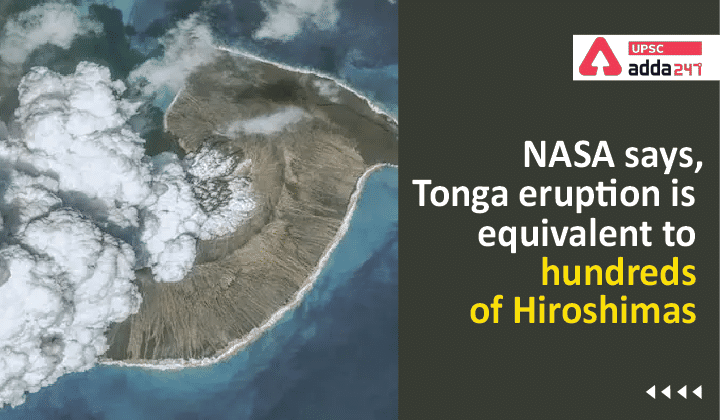Table of Contents
Hunga Tonga eruption: Relevance
- GS 1: Important Geophysical phenomena such as earthquakes, Tsunami, Volcanic activity, cyclone etc.
Hunga volcanic eruption: Context
- Recently, large volcanic eruptions at Hunga Tonga-Hunga Ha’apai produced plumes that reached the stratosphere and caused significant regional effects.
Hunga Tonga-Hunga Ha’apai: What happened?
- On 14th and 15th January, Hunga Tonga-Hunga Ha’apai, an underwater volcano in the South Pacific, erupted and shot debris as high as 25 miles into the skies.
- It generated a 7.4-magnitude earthquake, which triggered tidal waves that slammed into the island, covering it in ash and cutting it off from outside assistance.
- The explosive eruption was the biggest volcanic event recoded anywhere in the world in over three decades.
- The eruption produced an ash cloud 260-km wide and rising up nearly 39km into the sky.
- Within the cloud were electric storms that produced up to 400,000 lightning strikes in three hours.
- The volcanic eruption also triggered a tsunami causing waves across the Pacific Islands, Australia, New Zealand, Japan, as well as the west coast of North and South America.
- This was the first instance when a volcanic eruption caused an ocean-wide tsunami in the Pacific, instead of an earthquake.
- A massive shockwave followed the eruption and was observed from space in satellite imagery.
- The wave was recorded in seismometers around the globe — including in Alaska, over 9,000km away.

Hunga eruption equivalent to hundreds of Hiroshimas
- According to the NASA Earth Observatory, the eruption emitted between 5 and 30 megatons (5 million to 30 million tonnes) of TNT equivalent.
- In comparison, the US atomic bomb unleashed on Hiroshima, Japan, in 1945 was estimated to have been around 15 kilotons (15,000 tonnes) of TNT.
- TNT equivalent is a convention for expressing energy, typically used to describe the energy released in an explosion.
Hunga Tonga-Hunga Ha’apai volcano: What the scientists have said?
- NASA scientists said that the eruption of a submarine volcano in Tonga is helping them to understand how features formed on the surfaces of Mars and Venus.
- It is offering researchers a rare chance to study how water and lava interact.
- Studying the Hunga Tonga–Hunga Haʻapai volcano and its evolution in recent weeks is important for planetary science as the knowledge might help to reveal results of water–lava interactions on the red planet and elsewhere across the Solar System.
- The volcanic island, which began to form from ash and lava expelled from an undersea volcano in early 2015, attracted the researchers due to its similarity to structures on Mars and possibly also Venus.


About Hunga Tonga–Hunga Haʻapai
- Hunga Tonga–Hunga Haʻapai is a volcanic island that was built by undersea eruptions.
- Two pre-existing islands (Hunga Haʻapai and Hunga Tonga) were joined by the 2015 eruption into a single landmass.
- Ever since new land rose above the water surface in 2015 and joined two existing islands, the landmass was monitored by the researchers around the world.
- A team of researchers used a combination of satellite observations and surface-based geophysical surveys to track the evolution of the rapidly changing piece of Earth.
Also Read:



 TSPSC Group 1 Question Paper 2024, Downl...
TSPSC Group 1 Question Paper 2024, Downl...
 TSPSC Group 1 Answer key 2024 Out, Downl...
TSPSC Group 1 Answer key 2024 Out, Downl...
 UPSC Prelims 2024 Question Paper, Downlo...
UPSC Prelims 2024 Question Paper, Downlo...




